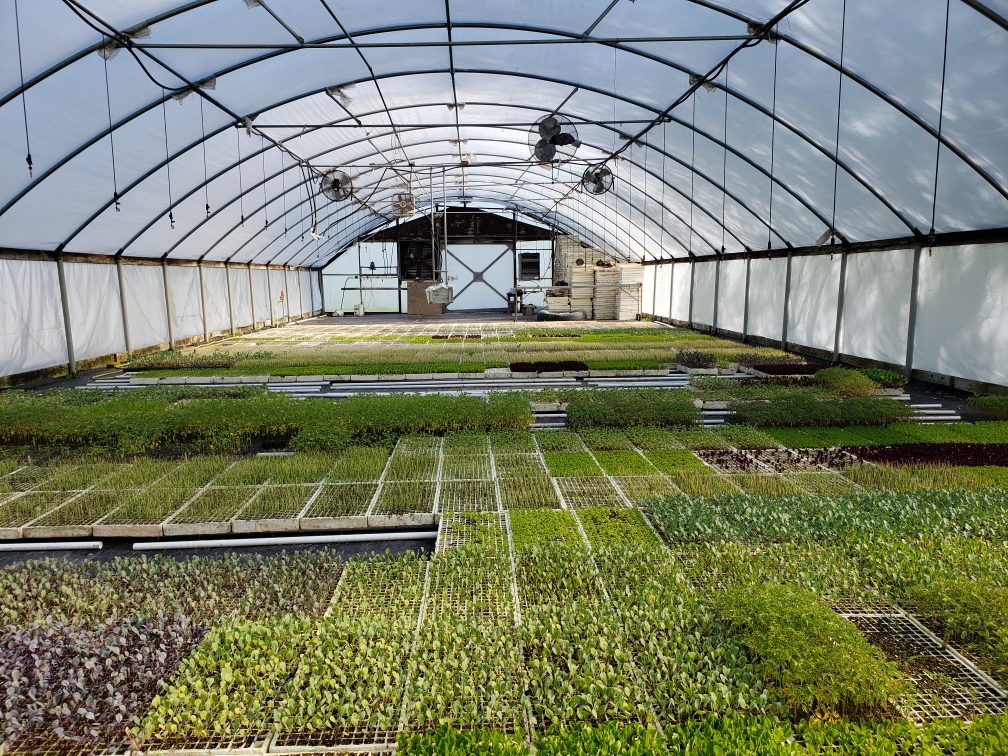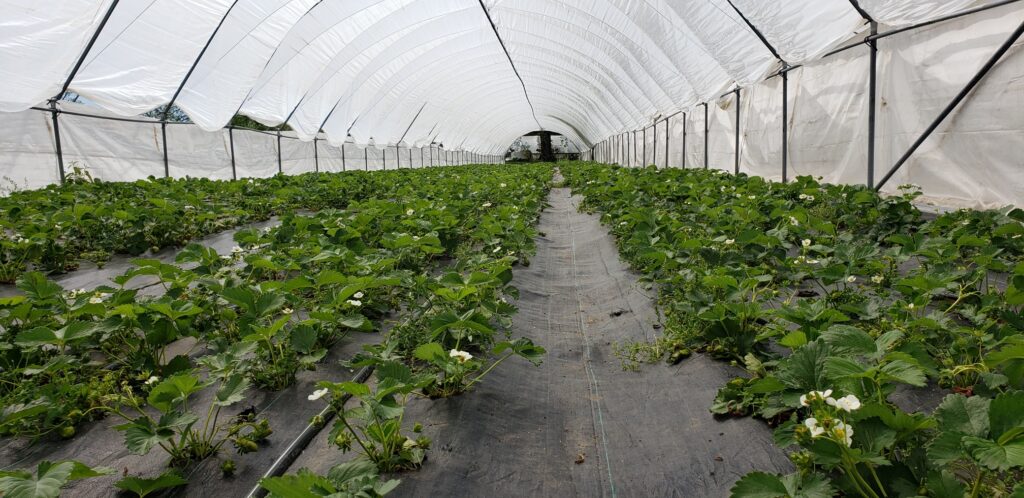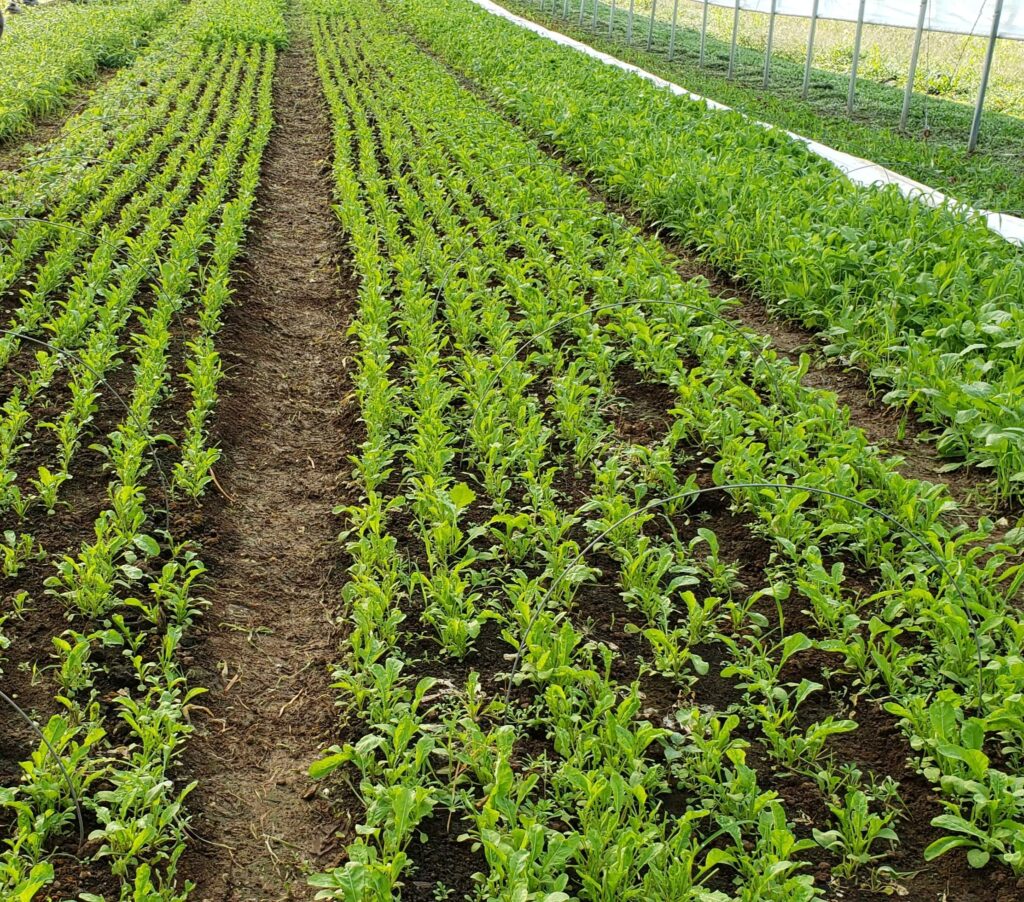For part three of our Elmwood Stock Farm tour, we’ll leave behind the cattle field and turn to see the cluster of clear plastic quonset hut-shaped greenhouses. A brief walk past the perennial herb beds and rows of rhubarb lands us in the transplant greenhouse.

Seed Starting
First to catch your eye will be the quiltwork of colors that lay before you. Being in the CSA business, we strive to have a diverse array of veggies in each week’s shares, so we plant a dizzying variety of foods—235 different varieties of seeds this year, to be exact. Each seed tray has 200 little cells, and in each of those is one plant, 1 to 3 inches tall. There must be tens of thousands of seedlings in the transplant greenhouse at any one time, each with their own hue of green and red.
Each spring, we spend a small fortune to get Elmwood Stock Farm’s vegetable production up and running: seeds, propane to heat the greenhouse, and people to seed and water. The CSA Farm Share program is essential here, as shareholders finance these seasonal startup costs with their upfront season-long investment. You can imagine it would be a hard sell at the bank: “Mr. Banker, will you lend us $100k even though we are not going to use the recommended chemicals to manage our widgets and organic is not just a passing fad and some people say it tastes good?” That’s where they would stop listening. So thanks, again, to our CSA shareholders for making this sixth-generation family farm possible.
The first question in the greenhouse is usually: How do all these little plants get put out in rows in the field? Let’s step outside. One of our setters is parked under the big oak tree.

This implement, the size of a VW bug, hooks to the rear of a tractor. Facing away from the driver and behind a large water tank sit two people, 40 inches apart, riding with trays of plants. As the tractor goes down the crop rows, the setters (this time meaning the people) gently extract one little plant from its cell and drop it into one of five 6-inch-wide plastic cups that circle around between their knees. As the cup cycles away, the bottom of the cup opens, allowing gravity to pull the plant into a furrow. The root ball gets a shot of water before press wheels come behind and gently firm the soil around each plant. A driver and two setters can set thousands of plants in an hour with one of these implements. Can you imagine how long it would take to plant each one of these on hands and knees with a trowel?
There are several other implements sorta neatly parked around the area—cultivators, discs, trailers, other setters, parts of relics from the past and complete relics of the past. The main equipment shed is nearby, where tractors and sensitive-to-the-weather implements, like hay balers, live.

Year-Round Veggies
Next stop: Five high tunnels are strategically placed in rows for growing plants in the ground in a protected environment. These unheated greenhouse-like structures buffer the plants from extreme winds, rains, cold and heat—things that can disrupt plant growth.
This is coveted growing space because there’s not very much of it. Specialty, grafted heirloom tomatoes earn a place in one of these houses each year, rotated to a new house each season for organic disease- and insect-disruption principles. One of our strawberry beds is in another, as we get a higher percentage of salable fruit from this safe space.
The real beauty of these structures is the year-round greens-growing potential they offer. While the high tunnels do not keep the crop from freezing in really cold weather, they buffer the elements enough that the plants do not perish, simply have slower growth. On a sunny day in winter, it can reach 70 degrees F in these spaces, and the ground never freezes, which keeps us in business.
We have our planting schedule in hand, seeds and transplants at the ready, to prepare one high tunnel for December harvest and the others for January, February and March—in time for Winter CSA Farm Shares.
Running cattle in these high tunnels for five years is not such a great idea—you’ve heard about the bull in the china shop—so we are most diligent about crop rotation and cover cropping for “green manure,” which is the process of incorporating nutrient-rich plants into the soil to feed the microbes.
High-tunnel irrigation is vital, since it never rains in there, so we employ sprinklers, drip lines and hand watering, as indicated. It is quite rewarding to peel open the high tunnel door on a snowy morning to find bright-green greens, ready for the picking. Yes, to all the heads that are shaking, it is a lot of work.

Intensive Greens Beds
As we head southeast from the greenhouse courtyard, notice the huge, old bur oak tree that predates our food-production operation by centuries.
We next come upon rows of nets or fabric draped over hoops alongside narrow, neat and tidy rows of plants. The colors here are arranged in lines, not rectangles as they were in the greenhouse. These are our intensive-greens-production beds. Here we employ a choreographed leafy-greens production system. Still solar powered, mind you, just more hands-on than the beef you learned about earlier.
We till the ground to a very shallow depth every eight to 10 days. Counterintuitively, we want to stimulate weed-seed germination. By doing this several times, the most viable seeds in that upper seed zone get burned out, so our teeny, tiny greens seeds will have less competition for a few extra days. Once the greens germinate, emerge and grow a little, we can use hand tools, like hoes and the push-wheel cultivator, to cultivate away the weeds that are starting to catch up.
The arsenal of tools, implements and techniques available to us today—an outgrowth of the local food movement—is staggering. This is well illustrated in our intensive-greens area. We reach for an array of fabrics to cover the beds, based on insect pressure and our need for temperature and moisture regulation. And we have hand tools of various shapes, sizes and purposes for precision seeding and weeding.
We combine all this previously unavailable technology with the biological principles that guide our lives to consistently grow nutritious leafy greens. The challenge is navigating weather, weeds and insect populations. For example, those flea beetles that hop from leaf to leaf, eating little holes in each one, are not present in colder weather, but then freezing temps are to be dealt with. We are still refining our system—and may be forever refining our system—with you in mind.
If you have any questions, send them in. Next week, we’ll head out to the vegetable fields, then on to the chickens, turkeys and pigs.


Made with 
